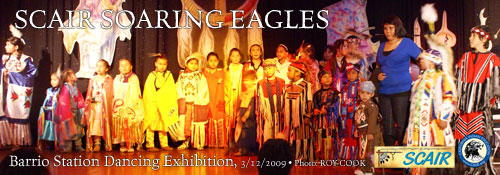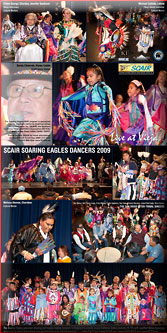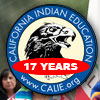 |
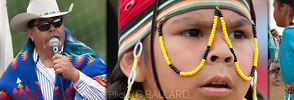 |
 |
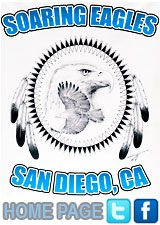
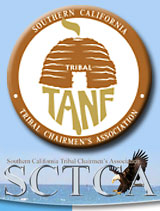

Publishing Corner: Indian Community: Science & Wonder Indian Heros: California Indian Art: CALIE Library: Academic Financial Aid: Tribal Governments: Indian Gaming: |
Soaring Eagles Performance, Social Powwowby Roy Cook, Opata-Oodham, Mazopiye Wishasha: Writer, Singer, Speaker Monday evening; April 6, 2009 at the University of Oklahoma 8th Annual Native Women and Men Wellness Conference in the Town and County Mission Valley the Soaring Eagle Dancers enjoyed the opportunity to express our culture and traditions. For a timeless four hours we are, once again, in the circle of life. This circle contains aspects of the good red road that we lightly place our feet to. This circle is the entry path to that special place and songs that inspires us to dance beyond our physical selves. This evening there are many songs from good drums: Green River and the San Diego Inter-Tribal Singers. Everyone has an ample opportunity to dance and enjoy being what we are, Indian people.
The Soaring Eagle dancers are all San Diego area Indian children. Their outfits are colorful and worn with pride. Many are produced by a combined effort of their families. The San Diego American Indian Warriors Association attends for the gourd dance led by Richard Van Dyke Parker and is the Honor Color Guard. The Emcee, Randy Edmonds, acknowledged our Military Warriors now serving and past veterans of many campaigns. One can live a lifetime in shorter periods of time but for these good four hours in San Diego, California many of us had a dandy time. Edward ‘Chuck’ Cadotte is the Arena Director for this dance. Dance has always played an important role in Plains Indian cultures, as a central element in both religious and secular life. Less than 100 years ago, powwows did not exist, as we know them today. The continuity of culture has endured and Indian dance tradition will continue to remain and evolve though a variety of dance traditions that would eventually be defined as the modern powwow today. Among these traditions were summer gatherings of ceremonial and social dances, healing, memorial and warrior society dances held to honor and bring protection upon their members. Both these traditions, along with many other American Indian practices, underwent severe restrictions during the last century when the United States government, in its effort to prohibit certain Indian ceremonies, banned a number of dance-based traditions. Despite these bans, however, Plains Indian dancing did not entirely disappear. Ceremonies and dances went “underground” and were held on the far reaches of reservations in secret, or were masked as other types of events entirely. In these forms dance continued to play a part in Plains Indian life, although a quiet one, during this culturally repressive time. It was not until 1933 that the government lifted its oppressive religion and cultural bans on American Indian Art and Dance could once again take an active, public place in American Indian life. At the end of World War II with the return of Indian soldiers from abroad, the warrior society dances of the past century began to acquire new meaning. Additionally, returning Korea and Cold War warriors were honored at powwows or “Homecoming Dances,” as they were sometimes called on the Southern Plains, which included the songs, dances and regalia of earlier traditional warrior societies. Most prominently represented by the popular Gourd Clan Societies introduced by the Kiowa. Outside of the dance arena important social ties and customs were also rebuilt, including the honoring of elders, naming and adoption ceremonies, the reception of families back into public life following a period of mourning, and a general bonding between families and friends. The general structure of these early powwows resembled the summer dance celebrations of the past century and included the use of a camp crier, Eyapaha or announcer, the gathering of families to camp out at celebration grounds, and important social interaction among the participants. Before 1950, the term “powwow” was used only on the Southern Plains in reference to American Indian gatherings and celebrations of song and dance. However, powwows gained further prominence in the 1950s and 1960s throughout the Northern Plains region when Sioux, Crow, and Blackfeet tribes began to sponsor Wachipi, Intertribal gatherings for fun and dancing. Members of elite warrior societies, mostly based on the Omaha Heluska, held the original dances. This Omaha tribal origin is frequently acknowledged. There were a variety of names used by different tribes for these dances. Among them are Omaha Dance used by the Sioux, Hot Dance used by the Crow and Dakota Dance by the Cree. Urban powwows have continued to grow over the last sixty years; whereas 70 years ago most powwows took place on reservations, some of the biggest are now held in convention centers and gyms in large cities around the country. Today, the powwow is both a community gathering and cultural celebration. It is not a commercial event, nor is it purely “entertainment.” It is an important spiritual and social gathering of people to celebrate American Indian traditions, dance and social customs. Although the warrior societies and early Plains “Homecoming” powwows of the past were primarily the domain of male dancers, today’s powwows are open to everyone: men, women, and even small children. This family participation by: Elders, men and women and the ever popular “tiny tots” indicates that not only are music and dance alive and well in Plains Indian culture, but that they will continue to play an important role for generations to come. “Honor Dances,” “Specials” and “Giveaways” recognize the importance of families and individuals participating in the powwow and honor them for their commitment. Powwows help to keep song and dance a very real and contemporary part of Native American life. At the same time, the changes that powwows go through help to make them a living art form. It is important to realize that recent innovations and shared styles are not less traditional nor “unauthentic,” as dance dress styles and details still mark personal heritage as well as individual taste. We shall continue to ‘Remain’ and be who we are Indian people. Back to Roy Cook's Articles page.
+++++++ SOARING EAGLES Proudly Sponsored by: VOLUNTEERS NEEDED: If you would like to volunteer or help support the Golden Eagles Indian students, please contact Vickie Gambala off the SOARING EAGLES WEB SITE for current information, including current class and event schedules, contact information, FAQ, registration and eagles art posters DOWNLOAD. +++++++ POW-WOW REGALIA See Roy Cook's CALIE Pow-wow History and Information article for more info and professional photographs portfolios and movies about Native American powwows in Southern California, San Diego County. |
CALIF INDIAN EDU NETWORK: AHMIUM.org | SCAIR.org | SDICENTER.org | APAPAS.com
—
WEB SITE DESIGN
www.calie.org COPYRIGHT 2008-Present • ALL RIGHTS RESERVED
